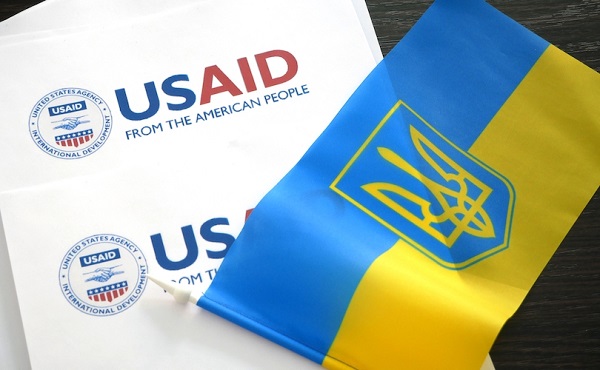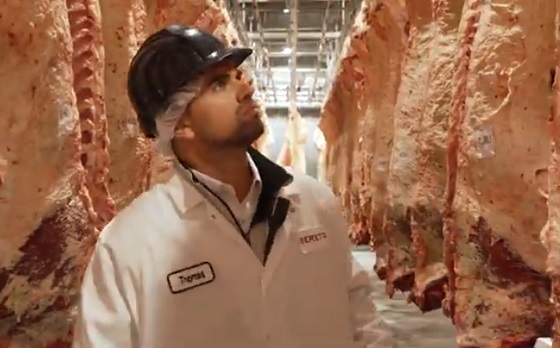Business
90% of Ukraine news outlets get funding from USAID: new report

From LifeSiteNews
By Matt Lamb
USAID, targeted by Elon Musk and Donald Trump for cuts, is a heavy funder of news outlets in Ukraine, according to a new report. The agency has come under scrutiny for wasteful and ideological projects.
The United States Aid for International Development (USAID) provides funds to 90 percent of Ukrainian news outlets, according to a new report from the Columbia Journalism Review and Reporters Without Borders.
While much focus has been on USAID and other federal entities subscribing to news outlets such as Politico, a broader issue may be taxpayers paying for news coverage in foreign countries.
Working off data from Reporters Without Borders, the Columbia Journalism Review reported that “USAID had boasted of supporting more than six thousand journalists, around seven hundred independent newsrooms, and nearly three hundred media-focused civil society groups in thirty or so countries.”
The Trump administration reportedly froze $268 million for these endeavors.
“RSF also noted the harsh effect on journalism in Ukraine, where 90 percent of news organizations rely on USAID funding, some very heavily,” the Journalism Review reported.
The United States has spent nearly $66 billion on direct military assistance to Ukraine in its ongoing war against Russia. Taxpayers have sent another $120 billion or so to the country in other foreign aid, according to an inspector general report current as of September 30, 2024.
The journalism groups released the reports ostensibly to defend U.S. funding of outlets.
On a related issue, the Trump administration is also cutting off taxpayer-funded subscriptions that government employees set up with news outlets.
“I can confirm that the more than $8 million taxpayer dollars that have gone to essentially subsidizing subscriptions to Politico on the American taxpayers’ dime will no longer be happening,” White House Press Secretary Karoline Leavitt said during a press conference yesterday.
Politico itself had not received $8 million in subscriptions, but the press secretary, who said she learned of the issue right before the briefing, was referring to outlets in general.
“The DOGE team is working on canceling those payments now,” she said.
She stated further:
Again, this is a whole-of-government effort to ensure that we are going line by line when it comes to the federal government’s books. And this president and his team are making decisions across the board on ‘Do these receipts serve the interests of the American people? Is this a good use of the American taxpayers’ money? If it is not, that funding will no longer be sent abroad and American taxpayers will be seeing significant savings because of that effort.
Conservatives celebrated the news.
“The Federal Government is not a good steward of your tax dollars,” Josh Tanner, an Idaho state representative, wrote on X. “They spent $8 Million on propaganda media. This is even more of a reason for Idaho tax dollars to be accounted for, applied appropriately, and reduced where necessary. The Fed has failed, our state must succeed.”
“Even if the govt money to Politico wasn’t an outright grant, providing $8 Million in taxpayers funds for ‘subscriptions’ to a super Lefty publication is just absurd and abusive to hard-working Americans!” conservative commentator Steve Cortes wrote.
A payroll issue with Politico‘s payroll was initially blamed on the funding freeze, though the company said it was a “technical error” that created the problem.
USAID under scrutiny, uses tax dollars to promote DEI around the world
The Trump administration has closed, at least temporarily, USAID. Secretary of State Marco Rubio is now the administrator of the agency, which has funded a variety of ideological projects across the globe.
“USAID has a history of ignoring [the national interest of the United States] and deciding that they’re a global charity. These are not donor dollars, these are taxpayer dollars,” Secretary Rubio said recently.
Leavitt highlighted some of the ideological and wasteful projects funded through this agency, including “$1.5 million to advance DEI in Serbia’s workforce.”
The agency has also been used to pressure conservative, poorer countries into adopting pro-abortion policies, as LifeSiteNews previously reported.
State Department spokeswoman Tammy Bruce highlighted other wasteful projects in a post on X.
She listed projects the freeze had stopped, including “$16 million in unjustified funding for institutional contractors in the gender development offices,” “$4 million to unjustified funding for the Center for Climate-Positive Development,” and “$600,000 to fund technical assistance for family planning in Latin America.”
Business
Dallas mayor invites NYers to first ‘sanctuary city from socialism’

From The Center Square
By
After the self-described socialist Zohran Mamdani won the Democratic primary for mayor in New York, Dallas Mayor Eric Johnson invited New Yorkers and others to move to Dallas.
Mamdani has vowed to implement a wide range of tax increases on corporations and property and to “shift the tax burden” to “richer and whiter neighborhoods.”
New York businesses and individuals have already been relocating to states like Texas, which has no corporate or personal income taxes.
Johnson, a Black mayor and former Democrat, switched parties to become a Republican in 2023 after opposing a city council tax hike, The Center Square reported.
“Dear Concerned New York City Resident or Business Owner: Don’t panic,” Johnson said. “Just move to Dallas, where we strongly support our police, value our partners in the business community, embrace free markets, shun excessive regulation, and protect the American Dream!”
Fortune 500 companies and others in recent years continue to relocate their headquarters to Dallas; it’s also home to the new Texas Stock Exchange (TXSE). The TXSE will provide an alternative to the New York Stock Exchange and Nasdaq and there are already more finance professionals in Texas than in New York, TXSE Group Inc. founder and CEO James Lee argues.
From 2020-2023, the Dallas-Fort Worth-Arlington MSA reported the greatest percentage of growth in the country of 34%, The Center Square reported.
Johnson on Thursday continued his invitation to New Yorkers and others living in “socialist” sanctuary cities, saying on social media, “If your city is (or is about to be) a sanctuary for criminals, mayhem, job-killing regulations, and failed socialist experiments, I have a modest invitation for you: MOVE TO DALLAS. You can call us the nation’s first official ‘Sanctuary City from Socialism.’”
“We value free enterprise, law and order, and our first responders. Common sense and the American Dream still reside here. We have all your big-city comforts and conveniences without the suffocating vice grip of government bureaucrats.”
As many Democratic-led cities joined a movement to defund their police departments, Johnson prioritized police funding and supporting law and order.
“Back in the 1800s, people moving to Texas for greater opportunities would etch ‘GTT’ for ‘Gone to Texas’ on their doors moving to the Mexican colony of Tejas,” Johnson continued, referring to Americans who moved to the Mexican colony of Tejas to acquire land grants from the Mexican government.
“If you’re a New Yorker heading to Dallas, maybe try ‘GTD’ to let fellow lovers of law and order know where you’ve gone,” Johnson said.
Modern-day GTT movers, including a large number of New Yorkers, cite high personal income taxes, high property taxes, high costs of living, high crime, and other factors as their reasons for leaving their states and moving to Texas, according to multiple reports over the last few years.
In response to Johnson’s invitation, Gov. Greg Abbott said, “Dallas is the first self-declared “Sanctuary City from Socialism. The State of Texas will provide whatever support is needed to fulfill that mission.”
The governor has already been doing this by signing pro-business bills into law and awarding Texas Enterprise Grants to businesses that relocate or expand operations in Texas, many of which are doing so in the Dallas area.
“Texas truly is the Best State for Business and stands as a model for the nation,” Abbott said. “Freedom is a magnet, and Texas offers entrepreneurs and hardworking Texans the freedom to succeed. When choosing where to relocate or expand their businesses, more innovative industry leaders recognize the competitive advantages found only in Texas. The nation’s leading CEOs continually cite our pro-growth economic policies – with no corporate income tax and no personal income tax – along with our young, skilled, diverse, and growing workforce, easy access to global markets, robust infrastructure, and predictable business-friendly regulations.”
Business
National dental program likely more costly than advertised

From the Fraser Institute
By Matthew Lau
At the beginning of June, the Canadian Dental Care Plan expanded to include all eligible adults. To be eligible, you must: not have access to dental insurance, have filed your 2024 tax return in Canada, have an adjusted family net income under $90,000, and be a Canadian resident for tax purposes.
As a result, millions more Canadians will be able to access certain dental services at reduced—or no—out-of-pocket costs, as government shoves the costs onto the backs of taxpayers. The first half of the proposition, accessing services at reduced or no out-of-pocket costs, is always popular; the second half, paying higher taxes, is less so.
A Leger poll conducted in 2022 found 72 per cent of Canadians supported a national dental program for Canadians with family incomes up to $90,000—but when asked whether they would support the program if it’s paid for by an increase in the sales tax, support fell to 42 per cent. The taxpayer burden is considerable; when first announced two years ago, the estimated price tag was $13 billion over five years, and then $4.4 billion ongoing.
Already, there are signs the final cost to taxpayers will far exceed these estimates. Dr. Maneesh Jain, the immediate past-president of the Ontario Dental Association, has pointed out that according to Health Canada the average patient saved more than $850 in out-of-pocket costs in the program’s first year. However, the Trudeau government’s initial projections in the 2023 federal budget amounted to $280 per eligible Canadian per year.
Not all eligible Canadians will necessarily access dental services every year, but the massive gap between $850 and $280 suggests the initial price tag may well have understated taxpayer costs—a habit of the federal government, which over the past decade has routinely spent above its initial projections and consistently revises its spending estimates higher with each fiscal update.
To make matters worse there are also significant administrative costs. According to a story in Canadian Affairs, “Dental associations across Canada are flagging concerns with the plan’s structure and sustainability. They say the Canadian Dental Care Plan imposes significant administrative burdens on dentists, and that the majority of eligible patients are being denied care for complex dental treatments.”
Determining eligibility and coverage is a huge burden. Canadians must first apply through the government portal, then wait weeks for Sun Life (the insurer selected by the federal government) to confirm their eligibility and coverage. Unless dentists refuse to provide treatment until they have that confirmation, they or their staff must sometimes chase down patients after the fact for any co-pay or fees not covered.
Moreover, family income determines coverage eligibility, but even if patients are enrolled in the government program, dentists may not be able to access this information quickly. This leaves dentists in what Dr. Hans Herchen, president of the Alberta Dental Association, describes as the “very awkward spot” of having to verify their patients’ family income.
Dentists must also try to explain the program, which features high rejection rates, to patients. According to Dr. Anita Gartner, president of the British Columbia Dental Association, more than half of applications for complex treatment are rejected without explanation. This reduces trust in the government program.
Finally, the program creates “moral hazard” where people are encouraged to take riskier behaviour because they do not bear the full costs. For example, while we can significantly curtail tooth decay by diligent toothbrushing and flossing, people might be encouraged to neglect these activities if their dental services are paid by taxpayers instead of out-of-pocket. It’s a principle of basic economics that socializing costs will encourage people to incur higher costs than is really appropriate (see Canada’s health-care system).
At a projected ongoing cost of $4.4 billion to taxpayers, the newly expanded national dental program is already not cheap. Alas, not only may the true taxpayer cost be much higher than this initial projection, but like many other government initiatives, the dental program already seems to be more costly than initially advertised.
-

 Energy1 day ago
Energy1 day agoB.C. Residents File Competition Bureau Complaint Against David Suzuki Foundation for Use of False Imagery in Anti-Energy Campaigns
-

 COVID-191 day ago
COVID-191 day agoCourt compels RCMP and TD Bank to hand over records related to freezing of peaceful protestor’s bank accounts
-

 Alberta2 days ago
Alberta2 days agoAlberta uncorks new rules for liquor and cannabis
-

 Crime2 days ago
Crime2 days agoProject Sleeping Giant: Inside the Chinese Mercantile Machine Linking Beijing’s Underground Banks and the Sinaloa Cartel
-

 C2C Journal24 hours ago
C2C Journal24 hours agoCanada Desperately Needs a Baby Bump
-

 International1 day ago
International1 day agoTrump transportation secretary tells governors to remove ‘rainbow crosswalks’
-

 Alberta1 day ago
Alberta1 day agoAlberta Next: Alberta Pension Plan
-

 Agriculture12 hours ago
Agriculture12 hours agoLacombe meat processor scores $1.2 million dollar provincial tax credit to help expansion




